Abstract
Tidal power industry has made significant progress towards commercialization over the past decade. Significant investments from sector leaders, strong technical progress and positive media coverage have established the credibility of this specific renewable energy source. However, its progress is being retarded by operation and maintenance problems, which results in very low operational availability times, as low as 25 %. This paper presents a literature review of the current state of tidal device operators as well as some commercial tidal turbine condition monitoring solutions. Furthermore, an overview is given of the global tidal activity status (tidal energy market size and geography), the key industry activity and the regulations-standards related with tidal energy industry. Therefore, the main goal of this paper is to provide a bird’s view of the current status of the tidal power industry to serve as a roadmap for the academia regarding the real needs of the tidal power industry.
1. Introduction
Global energy demand is forecast to increase by 60 % over the next 25 years [1]. To counter global warming and climate change, the EU has set a target for 20 % of its energy requirements to be supplied from renewable sources, amongst which tidal energy is currently viewed as an emerging and leading technology with large worldwide potential. By 2050, wave and Tidal Power (TP) is expected to reach an EU installed capacity of >100 GW [2] – sufficient to power 66 million European homes, helping the EU to meet its target of 80-95 % reduction in greenhouse gas emissions below 1990 levels. However, TP plants have not yet been fully commercialized and are currently driven through government or public sector subsidized projects.
TP, also called tidal energy, is a form of hydropower that converts the energy of tides into useful forms of power, mainly electricity. TP is an almost limitless (ignoring practical transmission distance constraints) source of reliable, renewable energy with many advantages over all other renewable energy types. TP can be classified into four generating methods [3]: (i) Tidal stream generators (TSGs), (ii) Tidal barrage, (iii) Dynamic TP and (iv) Tidal lagoon. TSGs make use of the kinetic energy of moving water to power turbines, in a similar way to wind turbines that use wind to power turbines.
TSG is a very attractive, renewable energy source because [4]: (i) It is environmentally unobtrusive with most of the necessary superstructure being invisible because it is below the sea surface, (ii) It is safe as with suitable mechanical screens or caging it is completely harmless to all forms of marine life and ship navigation, (iii) It involves negligible carbon emissions or other pollutants, (iv) The accessible TSG power resource is also massive, (v) The energy density stored in a tidal current is 800 times that in a normal wind for a given speed of current/wind, so that for a given power production tidal stream structures can be made much smaller than wind turbine structures, (vi) Tidal Stream Currents (TSC) are highly directional compared to wind so that neighbouring turbines in tidal stream farms (also called arrays) can be placed closer together than wind turbines, saving on construction, cabling and maintenance costs, (vii) Unlike wind turbines TSGs produce completely predictable variations in power over a 12 hour cycle so that it can be used as a sole source of power over larger regions and (viii) Construction companies involved can draw on decades of past experience in the installation of offshore oil platforms, without the hazards of fire and explosion that are associated with the latter, as well as capitalize on the knowledge gained from 20 years or so of wind turbine constructions.
One of the main problems with TSGs is that the Operations and Maintenance (O&M) of them represents 30 % of the total cost of energy production in tidal based plants [2]. Failure data relating specifically to marine current turbine operation is limited due to the lack of long term turbine operation and also due to the confidentiality of data obtained during industrial prototyping [5-7]. Underwater rotating components in the generator drive train will be subject to random and periodic wave loading involving stress cycles of much larger amplitude than arises with wind turbines, as well loading from marine fouling. The replacement of failed components is relatively expensive because of the underwater environment, especially if catastrophic failure is involved through the breakdown of one component in the generator drive train causing collateral damage in other components in the drive train.
The implementation of on-line condition monitoring systems can reduce maintenance costs, which will also become greater with generator’s age. Unscheduled maintenance in the harsh operating conditions of the tidal generators is a serious consideration for O&M costs. Continuous condition monitoring would reduce negative economic impacts due to the loss of power generation by reducing generator shut down time for maintenance, particularly during poor weather periods.
The paper is organized as follows: Section 2 presents the current status of the tidal energy market as well as its foreseen growth worldwide. In Section 3 the key tidal operators are listed along with some of their key technological features. Section 4 summarizes the regulations and standards for tidal energy and section 5 presents the currently available commercial monitoring solutions. Finally, section 6 concludes the paper.
2. Current and potential tidal energy market
The Sihwa Lake TP Station [8, 9] in Korea is the world’s largest TP installation, with a total power output capacity of 254 MW, surpassing the 240 MW Rance TP Station [10] which was the world's largest for 45 years prior to 2011. Estimates of potentially exploitable tidal and wave energy vary considerably. One estimate for the UK, which has a long coastline, for total tidal energy resource that could be practically exploited is about 121 TWh/y (12.5 GW mean power output), ~30 % of the present UK electricity output [11]. The total potential tidal resource in the EU is a factor of 2-3 higher. In one analysis, the UK’s Severn estuary alone has a TP potential of 8.64 GW [12]. The total world potential for ocean TP has been estimated variously as 64 GW [13] and 90 GW-120 GW [14]. Data in 2004 gave global energy consumption at about 16,424 TWh/y (1,875 GW) [15] so tidal energy could supply ~10 % of world electricity need.
With a more conservative estimate of 25 GW Atlantis Resources [16] has mapped the geographical distribution of currently considered TP. Of the 25 GW foreseen over 11 GW is predicted for the UK, representing a major target region. Renewable UK [11] has examined the market in the context of the dominant Scottish activity. A summary of the global activity status is presented in the rest of this section and summarized in Fig. 1.
1) Europe. Intelligent Energy Europe’s funded projects SI Ocean (Strategy, 2012-2014) [17] and TP Ocean (Technology) [18] have studied the market strategy, potential clients and market focus groups for Europe’s Atlantic coast. France: Brittany, the French Government and the EU have all contributed to a project deploying four 2 MW tidal turbines off the coast of Paimpol-Bréhat to create the world’s largest tidal array exporting power into the electricity grid [19]. Portugal: The Portuguese Marine National Plan has been published, aimed at ensuring the sustainable use of marine resources by a variety of users. Spain: The Spanish Government’s Renewable Energy Plan 2011-2020 includes a target for an annual installation rate for marine energy of 20-25 MW between 2016 and 2020. The plan states that 100 MW is expected to be installed by 2020, producing 220 GWh/year by then. United Kingdom: In the UK, the exploitable tidal energy resource has been estimated as ~100 TWh per year of electricity in water depths of 40 m, equivalent to about one quarter of the UK’s current annual electricity consumption [20]. Many tidal generators are able to operate in even deeper water depths than this, offering the opportunity to considerably increase the UK’s potential resource. To access this, it is likely that devices with power capacities between 250 kW and 5 MW will be used. Over 26 GW of capacity will be needed to fully capture this TP, resulting in a market in the UK alone for many thousands of devices [21]. In Orkney the European Marine Energy Centre (EMEC) opened in 2003 as the world’s only grid-connected, full-scale wave and tidal energy converter testing and accreditation facility in real sea conditions, contributing approximately £149M to Orkney since 2003.
Fig. 1Quantified global resource of 25 GW, equivalent to 16,000 turbine sales. Source: Atlantis Resources, October 2014
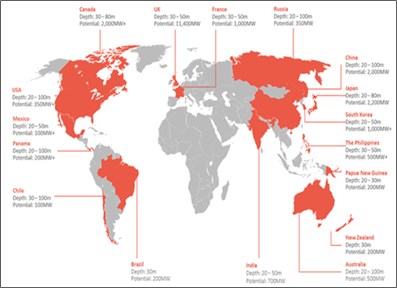
2) Asia. Turkey: Turkey has a strong incentive to use indigenous resources to generate power. Turkey imports 75 % of its energy as gas from Russia, Iraq and Iran. The US Trade and Development Agency has awarded Verdant Power of New York and the Turkish government a grant to study the feasibility of installing a Verdant Power Kinetic Hydropower System (KHPS) downstream of the Seyhan dam hydroelectric power plant, located near Adana [22]. China: A national project has been started to construct a pilot zone and offshore test sites. Japan: Marine energy research and development was allocated a total budget of the equivalent of approximately £50M for the years 2011 to 2015. South Korea: The government has set a target that 11 % of the national energy demand comes from new and renewable energy by 2030. Ocean energy, including wave and tidal is targeted to contribute 4.7 % to the new and renewable total.
3) America. Canada: Canada’s Marine Renewable Energy Technology Roadmap sets out the path to the commercialisation of marine energy in Canada. This is supported by funding via the ecoENERGY Innovation Initiative. The Fundy Ocean Research Centre for Energy (FORCE) in Nova Scotia acts as an industry incubator similar to EMEC. United States of America: The US Government Water Power Program is currently assessing the opportunities associated with ocean energy resources. This is anticipated to inform the establishment of aggressive national goals for marine energy technology deployment.
4) Australia. New Zealand: The Marine Energy Deployment Fund was set up in 2007 with the aim of bringing forward the development of marine energy in New Zealand by supporting the deployment of devices. Grants to the equivalent of approximately £2.1M were allocated in four annual rounds between 2007 and 2011.
Note: Additionally, Australia, Belgium, Denmark, Germany, Ireland, Italy, Mexico, Norway and Sweden also have an active interest in marine energy and are members of the Ocean Energy Systems Implementing Agreement (IEA-OES).
3. Tidal device operators
Machines of 1 MW and above are at a size which are considered commercially credible and are thus representative of the future customer base for monitoring solutions. These 1 MW+ machines will be high-technology, high value systems at an installed, capital cost in the order of £3.5 M/MW and a high operational cost. Health condition monitoring technology is likely to be cost effective and in demand with potential significant growth of this high-technology market. Key industry activity includes the following companies:
Alstom [23] bought Rolls-Royce’s Tidal Generation Ltd (TGL) in 2012. They installed and tested a 0.5 MW turbine at the EMEC at Orkney. The turbine design is the closest to wind turbines, with a hermetic nacelle where the gearbox is connected to a generator probably with a coupling. TGL also installed a 1 MW turbine in Orkney in 2013. It is connected to the Scottish grid. Alstom is a participant of ReDapt project (Reliable Data Acquisition Platform for Tidal) which is co-funded by ETI (Energy Technologies Institute). Alstom started designing Oceade 18, a 1.4 MW turbine with 18 m rotor in 2014 (Fig. 2).
Fig. 2Oceade’s 18 – 1.4 MW turbines commercial deployment. Source: Alstom
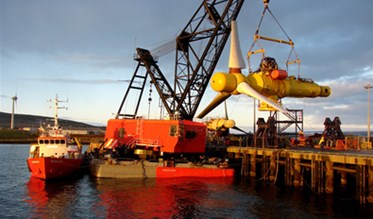
Siemens, Marine Current Turbines Ltd (MCT) [24] developed and installed a dual 1.2 MW turbine, SeaGen-S, near Lynmouth, Devon coastline. It uses 460 kNm gearboxes, the speed of rotation of the high speed shaft is 1000 rpm, and the estimated output torque is 6.44 kNm. They have got a web based turbine condition monitoring system employing temperature, oil pressure and vibration sensors. It looks like Siemens gearbox is directly connected to a generator without a hermetic nacelle (a short coupling seems to be protected by a hermetic cylindrical housing). Currently MCT (Siemens) is offering SeaGen-S 2 MW dual turbines that are going to be installed at the West Islay Tidal Farm, Scotland. MCT’s 1.2 MW SeaGen device installed in Strangford Lough, Northern Ireland has been successfully operated for 2 years and has delivered 2 million units (2 GWh) of electricity to the National Grid, enough to keep 1,500 homes powered for two years. DP Marine Energy (DPME) [25] together with DEME Blue Energy (DBE) [26] is developing the West Islay Tidal Farm. In the first phase, 30 turbines of the total power of 30 MW should be deployed by 2016. Later the farm will be expanded to 400 MW by 2024. At least 6 MW will be generated by MCT SeaGen-S turbines. Other technologies include Alstom 1 MW TGL turbines and Hammerfest turbines. Hammerfest Strom [27] is one of the longest standing players in the tidal energy market, and has the largest number of testing hours of any developer with their HS300, 0.3 MW prototype turbine established in Norwegian fjord in 2002. This turbine was removed, inspected and reinstalled after 6 years of service. International technology group Andritz acquired a 33.3 % stake in Hammerfest Strøm in 2010 providing strategic technical support and the necessary capital to drive the HS1000 project forward. ANDRITZ HYDRO Hammerfest (AHH) installed 1 MW turbine at EMEC in 2011. Now they offer turn-key TP plants consisting of several turbines connected to grid (25 years of service, maintenance every 5 years). Atlantis Resources Ltd (ARL) [28]. They installed a double rotor AR1000 (1 MW) turbine at EMEC in 2011. It has a hermetic nacelle. Now they have got AR1500 turbine available for installation. MeyGen Ltd [29] plans to deploy 398 MW turbines connected to the UK National Grid in early 2020s. Currently they are doing testing of prototype turbines. They work in cooperation with Atlantis Resources and AHH. Tidal Stream Ltd [30] develops platforms that can carry several turbines in one installation. A small model of their platform was tested in the Thames. Their project, TRITON T6, uses six turbines generating up to 10 MW power. Scottrenewables TP Ltd [31] has developed and installed at EMEC a floating turbine (SR250, 250 kW turbine in 2012 and SR2000 is being developed and planned to be deployed in 2017 (Fig. 3)). Bluewater Energy Services [32] Holland, installed a BlueTEC 200 kW floating platform for two Italian turbines (made by Ponte di Archimede, PDA [33]) near Texel in Q2 2015. A bigger BlueTEC 2MW is being developed.
OpenHydro [34] is developing an open core turbine which is an uncommon configuration. OpenHydro’s 1 MW device (Fig. 4) was installed in the Bay of Fundy, Canada at the end of 2009. The device was damaged and put out of action due to blade failure in spring of 2010. The machine was recovered in December 2010. The cause of the failure is unknown, and the event damaged the progress and commercial reputation of OpenHydro (this type of failure and the consequential lost revenue clearly demonstrates a need in the market for condition monitoring technology). As of April 2015 OpenHydro has won $6.3M for the development of a tidal array in Canada [35].
Fig. 3SR2000 Operation Mode. Source: Scottrenewables TP Ltd
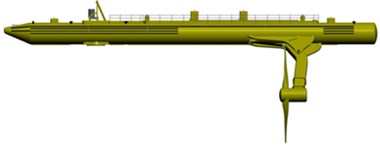
Fig. 4OpenHydro’s commercial deployment. Source: OpenHydro
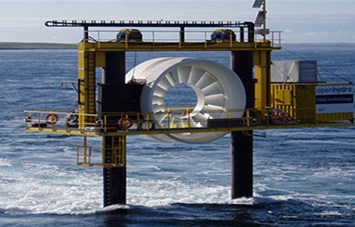
Fig. 5Verdant Power’s commercial (KHPS) deployment. Source: Verdant. Risk factors
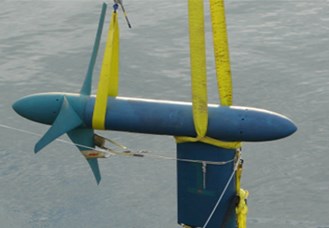
Voith Hydro [36] Germany has a 1 MW HyTide1000 turbine installed since 2013. It has no gearbox and it is directly coupled to a generator. Bearings are lubricated by sea water. Ocean Renewable Power Company (ORPC) [37] Since 2013 ORPC has been working on a number of projects in the USA and Chile. Nautricity [38] has utilised buoyancy and contra-rotation in their 2nd generation 500 kW Contra Rotating Marine Turbine (CoRMAT) to reduce the foundation loading, allowing a single point mooring system to be used. The rotor torque from contra-rotating rotors cancels out in order to leave a negligible net total torque on the mooring and foundation. The use of buoyancy is a significant feature of second generation tidal turbines, allowing the rotor to be located higher in the water column in order to access the higher flow speeds. CoRMAT has successfully completed its proof of concept testing and has generated electricity at sea. Nautricity is also developing HydraGlide, a surface float for the CoRMAT device that will allow the turbine to maintain an optimal position within the water column. In 2014 Tidal Energy Ltd (TEL) [39] installed the first full-scale generator known as DeltaStream™ in Ramsey Sound in Wales. The 1.2 MW DeltaStream™ concept demonstrator is developed in ongoing collaboration with Cranfield University and consists of three independent 0.4MW turbines. TEL’s main funder is Eco2 Ltd. TEL has also received support from Carbon Connections UK Ltd, as well as grants from the European Regional Development Fund (ERDF) through the Welsh Government, and the Carbon Trust. Pulse Tidal Ltd’s 1 MW+ PSCD device was developed under the EC FP7 programme. The Pulse Tidal approach uses oscillating hydrofoils, which lie horizontally in the water and sweep up and down. This means that the length of the hydrofoils, or blades, is not limited by the depth of the water. In 2009, Pulse Tidal deployed the 100 kW “Pulse-Stream 100” in shallow water in the mouth of the River Humber in the UK. The PS100 began generating electricity in May 2009, and they were exporting the power to Millenium Chemicals, a large plant on the South bank of the estuary. Pulse Tidal was awarded an Agreement for Lease (AFL) to deploy a full-scale demonstration device off Lynmouth in Devon 2014 but went into liquidation in 2014 due to poor power generation performance. Tidal Sails [41] is a Norwegian company developing and constructing pultrusion composite sail profiles arranged as a triangular array running on two belt loops with the current at an angle, capturing energy and converting it into clean electricity. Linearly moving sails have some inherent advantages over rotating turbine solutions when it comes to extraction efficiency, weight and maintenance, thus dramatically reducing the cost of the electricity. Tidal Sails until recently had a small scale demonstrator operating in a stream outside Haugesund, Norway. With a nominal capacity of 28 kW, it provided a basis for scaling up systems to the range of several MWs, since the hydrodynamic forces at work remain the same – irrespective of scale. Small scale demonstrator testing is completed and Tidal Sails is currently preparing installation of full scale systems including commercial installations consisting of multiple units, each with a nominal capacity between 2-10 MW. Several units may be installed in a tidal stream and consequently represent a considerable production of clean renewable electricity in the range of 10-100+ GWh a year. Verdant Power [42] was established in 2000 and is based in New York, USA. The central component of its KHPS (Fig. 5) is a horizontal-axis turbine equipped with an open three-bladed rotor. The turbines are installed fully under water, invisible from shore and self-rotate into the prevailing current so that the blades are optimally aligned to generate power. In tidal settings the turbines turn through ~170 degrees to generate power from both the ebb and flood flows. Verdant Power has a US funded project to study the feasibility of installing a Verdant Power KHPS downstream of the Seyhan dam hydroelectric power plant in Ardana, Turkey.
4. Regulations and standards
EMEC has coordinated the development of a suite of guidelines on behalf of the marine renewable energy industry [43]. Each document has been written by an acknowledged expert and progressed by a working group with individuals representing technology developers, regulators, academia, utilities, and project developers – a true cross-section of the marine energy industry. These draft standards and guides were released in 2009. (i) Assessment of Performance of Wave Energy Conversion Systems [44], (ii) Assessment of Performance of Tidal Energy Conversion Systems [44], (iii) Assessment of Wave Energy Resource [45], (iv) Assessment of Tidal Energy Resource [46], (v) Guidelines for Health & Safety in the Marine Energy Industry [47], (vi) Guidelines for Marine Energy Certification Schemes [48], (vii) Guidelines for Design Basis of Marine Energy Conversion Systems [49], (viii) Guidelines for Reliability, Maintainability and Survivability of Marine Energy Conversion Systems [50], (ix) Guidelines for Grid Connection of Marine Energy Conversion Systems [51], (x) Tank Testing of Wave Energy Conversion Systems [52], (xi) Guidelines for Project Development in the Marine Energy Industry [53], (xii) Guidelines for Manufacturing, Assembly and Testing of Marine Energy Conversion Systems [54].
These guides have been used as basis for the development of International Standards for the marine renewable industry. One must keep in mind that the publishing of international standards is a lengthy process taking more than 3 years involving significant consultation on an international scale.
5. Current commercial turbine monitoring solutions
A Renewables UK report [55] analyses risks in the tidal energy sector. Its conclusion is that one of the most important risk factors is maintenance and survivability. Additionally, SI Ocean [56] (supported by the EU Intelligent Energy Europe programme) has listed the primary challenges of commercialization of TP generation: (i) Enabling technology, (ii) Risk management, (iii) Technology fragmentation and design consensus, (iv) Grid access, connectivity and infrastructure, (v) Economic perspective and (vi) Establishing equitable environmental mitigation measures.
Risk is, in this context, the probability of component failure within the service life of the TSG while reliability is the probability of the system components not failing during service. These challenges have resulted in the high cost of installation, operation and maintenance of TP plants. Alongside the development of TSGs, a number of O&M supporting technologies have appeared. These are sector technology transfer solutions, however, and none of them has been developed specifically for tidal energy. The data provided for successful monitoring of the subsea generators is of limited sensitivity in the noisy subsea environment, and in particular the systems based on minor variations of electrical output measurements are indirect, decoupled from individual components and hence relatively uninformative.
Since TSGs market is relatively new note many commercial monitoring systems exist while even the research literature is yet quite limited due primarily to the scarcity of available data [57], [58]. However, this is bound to change since the aging of the equipment will necessitate monitoring solutions within this remote and harsh environment to avoid catastrophic failures. A list of the currently available condition monitoring solutions for TSGs as well as key players that are close to developing monitoring system is given bellow.
The TidalSense Demo [59] EU funded project (2012) developed a structural health monitoring (SHM) device for wind (and tidal) energy generators using Long Range and Acoustic Emission ultrasonic sensors. Nautricity [38] were an end-user partner in this project. Epsilon Optics [60] produces load monitoring systems for marine blade and bearings based on fiber Bragg grating optics. Epsilon Optics provided instrumentation of AHH’s 1MW HS1000 turbine installed at the EMEC. This is an active system requiring a hardwired power and signal connection to the sensor element. Akoostix [61] produces environment monitoring devices for tidal plants based on sophisticated SONAR processing techniques, the ADEOS system. This provides indirect monitoring of the generators’ overall noise signatures within the ambient background. It is non-interventional but provides only non-targeted data for the entire system. Akoostix is the Environmental Monitoring Partner for Black Rock (TP) Inc., a berth holder at the Bay of Fundy’s Tidal Demonstration Site. SKF Group [62] produces bearings and monitoring accessories. Based on 100 years’ experience in this market, SKF Insight is developing smart bearings that use embedded sensors to monitor the critical parameters that are likely to lead to failure, e.g. lubricant contamination, excessive loads and temperatures. These have not yet been adopted by tidal generator manufacturers. Proviso-Systems [63] produces vibration monitoring devices for rotating engineering components including generators. It supplies the vbOnline condition monitoring system for the Enersur-Suez Energy 130 MW hydroelectric plant in Peru, considered a major benefit for remote SHM. No tidal vibration monitoring systems have yet been delivered. These systems measure only the important balance aspect of rotating shafts.
6. Conclusions
This paper summarized the current status of TSGs market and the related regulation and standardization issues. From the presented material it is apparent that the TSGs market is going to substantially expand within the next years which will create business opportunities for condition monitoring solutions. Currently only a handful companies provide solutions for condition monitoring in this area which means that research results directly applicable to TSGs monitoring can find their place in the market.
References
-
Hodge N. These numbers don’t lie: live from the renewable energy finance forum wall street. 2009.
-
Wave and Tidal Energy Market Deployment Strategy for Europe. SI Ocean, 2014.
-
Offshore Renewable Energy: Accelerating the Deployment of Offshore Wind, Tidal, and Wave Technologies, International Energy Authority Renewable Energy Technology Deployment (IEA-RETD). 2011.
-
Hardisty J. The Analysis of Tidal Stream Power. John Wiley and Sons, 2009.
-
Wolfram J. On assessing the reliability and availability of marine Energy converters: the problems of a new technology. Proceedings of the Institution of Mechanical Engineers, Part O: Journal of Risk and Reliability, Vol. 220, Issue 1, 2006, p. 55-68.
-
Thies P. R., Johanning L., Smith G. H. Assessing mechanical loading regimes and fatigue life of marine power cables in marine energy application. Proceedings of the Institution of Mechanical Engineers, Part O: Journal of Risk and Reliability, Vol. 226, Issue 1, 2012, p. 18-32.
-
Thies P. R., Flinn J., Smith G. H. Reliability assessment and criticality analysis for Wave Energy Converters. Proceedings of the 8th European Wave and Tidal Energy Conference, Uppsala, Sweden, 2009.
-
Kim G., Lee M. E., Lee K. S., Park J. S., Jeong W.M., Kang S. K, Soh J. G, Kim H. An overview of ocean renewable energy resources in Korea. Renewable and Sustainable Energy Reviews, Vol. 16, Issue 4, 2012, p. 2278-2288.
-
http://en.wikipedia.org/wiki/Sihwa_Lake_Tidal_Power_Station
-
Lebarbier C. H. Power from tides – The Rance tidal power station. Naval Engineers Journal, Vol. 87, Issue 2, 1975, p. 57-71.
-
Wave and Tidal Energy in the UK Conquering Challenges, Generating Growth. www.renewableuk.com, 2013.
-
Turning the Tide, http://www.sd-ommission.org.uk/publications.php?id=607
-
http://www.oceanenergycouncil.com/ocean-energy/tidal-energy
-
http://tidalenergytoday.com/2015/02/17/estimate-of-global-potential-tidal-resources
-
Department of Energy Report, http://www.eia.doe.gov/oiaf/ieo/highlights.html
-
http://atlantisresourcesltd.com/marine-power/global-resources.html
-
http://www.si-ocean.eu/en/upload/SI%20Ocean%20-%20WaveTidal%20Strategic%20Technology%20Agenda.pdf
-
http://www.oceanenergy-europe.eu/index.php/policies/technology-platform
-
http://www.power-technology.com/projects/paimpol-brehat-tidal-farm
-
https://en.wikipedia.org/wiki/List_of_countries_by_electricity_consumption
-
http://www.nautricity.com/investment/market-size
-
http://www.verdantpower.com/verdant---ustda.html
-
http://www.emec.org.uk/about-us/our-tidal-clients/alstom
-
http://www.energy.siemens.com/hq/en/renewable-energy/hydro-power/ocean-power.htm?stc=wwcg101057
-
http://www.dpenergy.com/projects
-
http://www.dtocean.eu/Partners/DEME-Blue-Energy
-
http://www.hammerfeststrom.com
-
http://atlantisresourcesltd.com/marine-power/tidal-current-power.html
-
http://www.meygen.com/the-project
-
http://www.tidalstream.co.uk
-
http://www.scotrenewables.com
-
http://www.bluewater.com/new-energy
-
http://www.pontediarchimede.it
-
http://www.openhydro.com/technology.html
-
http://www.openhydro.com/news/2015-04-16.html
-
http://voith.com/en/products-services/hydro-power/ocean-energies/tidal-current-powerstations--591.html
-
http://orpc.co/aboutorpc_company_aboutus.aspx
-
http://www.nautricity.com
-
http://www.tidalenergyltd.com
-
http://www.pulsetidal.com
-
http://tidalsails.com
-
http://www.verdantpower.com/kinetic-hydropower-system.html
-
Standards development funded by the Scottish Government and the Department for Business, Enterprise and Regulatory Reform. The International Electrotechnical Commission (IEC) formed Technical Committee (TC) 114: Marine Energy – Wave and Tidal Energy Converters. Each Participating Nation Has Formed a National Committee – UK designation PEL 114.
-
http://www.emec.org.uk/standards/assessment-of-performance-of-wave-energy-conversion-systems
-
http://www.emec.org.uk/standards/assessment-of-wave-energy-resource
-
http://www.emec.org.uk/standards/assessment-of-tidal-energy-resource
-
http://www.emec.org.uk/standards/guidelines-for-health-and-safety-in-the-marine-energy-industry
-
http://www.emec.org.uk/standards/guidelines-for-marine-energy-certification-schemes
-
http://www.emec.org.uk/standards/guidelines-for-design-basis-of-marine-energy-conversion-systems
-
http://www.emec.org.uk/standards/guidelines-for-reliability-maintainability-and-survivability-of-marine-energy-conversion-systems
-
http://www.emec.org.uk/standards/guidelines-for-grid-connection-of-marine-energy-conversion-systems
-
http://www.emec.org.uk/standards/tank-testing-of-wave-energy-conversion-systems
-
http://www.emec.org.uk/standards/guidelines-for-project-development-in-the-marine-energy-industry
-
http://www.emec.org.uk/standards/guidelines-for-manufacturing-assembly-and-testing-of-marine-energy-conversion-systems
-
Wave and Tidal Energy in the UK Conquering Challenges, Generating Growth. www.renewableuk.com, 2013.
-
http://www.si-ocean.eu/en/upload/docs/WP3/Gaps%20and%20Barriers%20Report%20FV.pdf
-
Wald R., Khoshgoftaar T. M., Beaujean B., Sloan J. C. A review of prognostics and health monitoring techniques for autonomous ocean systems. Proceedings of the 16th ISSAT International Reliability and Quality in Design Conference, 2010, p. 308-313.
-
Chacon J. L., Kappatos V., Selcuk C., Romero A., Jimenez J., Soua S., Gan T.-H. Development of a condition monitoring system for tidal stream generators rotating components combining acoustic emission and vibration analysis. Emerging Technologies in Non-Destructive Testing VI: Proceedings of the 6th International Conference on Emerging Technologies in Non-Destructive Testing, Brussels, Belgium, 2015.
-
http://www.tidalsense.com
-
http://epsilonoptics.com
-
http://www.akoostix.com/main/2014/03/akoostix-steps-up-to-support-responsible-tidal-power-generation
-
http://www.skf.com
-
http://www.proviso-systems.co.uk
